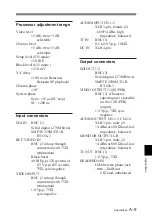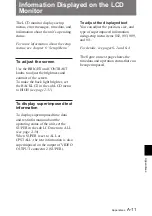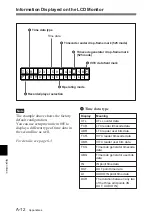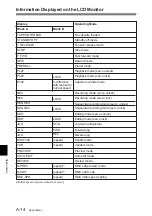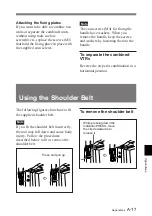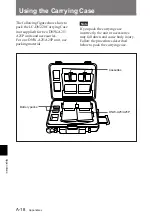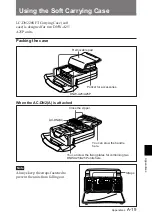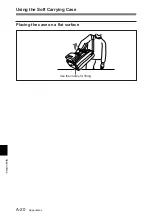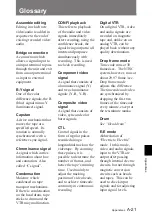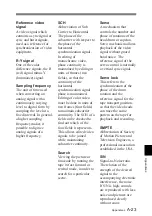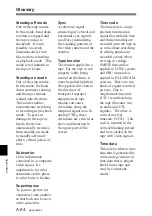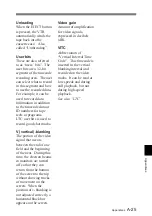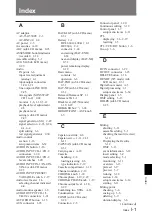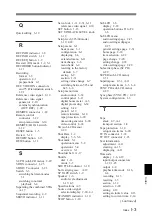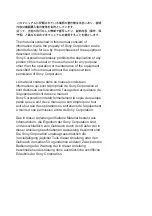
Appendixes
A-21
Appendixes
Glossary
Assemble editing
Editing in which new
video/audio is added in
sequence to the end of
existing recorded video/
audio.
Bridge connection
A connection which
allows a signal input to
an input terminal to pass
through the unit and exit
from an output terminal
as input to external
equipment.
B-Y signal
One of the color
difference signals, the B
(blue) signal minus Y
(luminance) signal.
Capstan
A drive mechanism that
moves the tape at a
specified speed. Its
rotation is normally
synchronized with a
reference sync signal.
Chrominance signal
A signal which carries
information about hue
and saturation. Also
called “C signal”.
Condensation
Moisture which
condensed on tape
transport mechanisms.
If there is condensation
on the head drum, tape
sticks to drum and the
VTR may malfunction.
CONFI playback
This refers to playback
of the audio and video
signals immediately
after recording, using the
confidence heads, the
signal being output to all
intents and purposes
simultaneously with
recording. This is used
to check recording.
Component video
signal
A signal that consists of
a luminance signal (Y)
and two chrominance
signals (Y–R, Y–B).
Composite video
signal
A signal that consists of
video, sync and color
burst signals.
CTL
Control signal in the
form of regular pulses
recorded along a
longitudinal track on the
videotape. By counting
these pulses, it is
possible to determine the
number of frames, and
hence the tape’s running
time. Used mainly to
adjust the tracking
position of video heads,
and to achieve timecode
continuity in continuous
recording.
Digital VTR
On a digital VTR, video
and audio signals are
recorded on magnetic
tape and, unlike on an
analog VTR, can be
played back without any
quality deterioration.
Drop frame mode
Time code runs at 30
frames/sec. The NTSC
system, however, runs at
about 29.97 frame /sec.
Drop frame mode
adjusts this difference.
The timecode and video
are synchronized by
dropping the first two
frames of the timecode
every minute, except at
the ten-minute marks.
Drum
See “Head drum”.
E-E mode
Abbreviation of
“Electric to Electric”
mode. In this mode,
video and audio signals
input to the VTR are
output after passing
through internal electric
circuits, but not through
magnetic conversion
circuits such as heads
and tapes. This can be
used to check input
signals and for adjusting
input signal levels.
Summary of Contents for DNW-A25
Page 1: ...DIGITAL VIDEOCASSETTE RECORDER DNW A25 A25P OPERATION MANUAL 1st Edition Revised 4 English ...
Page 100: ......
Page 136: ......
Page 162: ......



